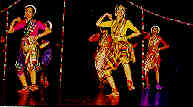
|
_________________________________________________
 | Festivals the world over are occasions of rejoicing celebration. All over the globe, every nation culture, religion have its own festivals. |
Festivals the world over are occasions of rejoicing celebration. All over the globe, every nation culture, religion have its own festivals. At times when festivals of two religions coincide there may be greater rejoicing or a communal riot. Festivals therefore, seem to be a part of religion. Performance of religious rites normally is an essential aspect of festivities. Many of our festivals, we are told, owe their origin to acts of the Gods; the birth of Lord Rama (Ramnavami), his return from exile (Diwali), the birth of Lord Krishna (Krishnastami or Janmastami) and so on. But mythology apart, two aspects about festivals that are evident are that they are occasions for rejoicing, and that they are social in character.
All Festivals are Social in Character
We do not know of any festival that is meant to be an occasion for grief nor one that: is celebrated individually in isolation. Why is it that these occasions of rejoicing have to be social in character?
Festivals are a reflection of social lifestyles. The answer to this question should lie in the manner in which festivals have originated. Man like most of the higher mammals, is social in nature. We see reindeer, zebras, baboons, gorillas etc. moving about in herds. To begin with Man also moved about in a herd which in the course of development took the form of a semi-nomadic tribe to later become villages, towns and cities. The earlier period of human social existence was characterised with a severe struggle for survival against forces of nature and against predatorv animals. Hunting followed by agriculture and now manufacturing industry have been his means of livelihood.
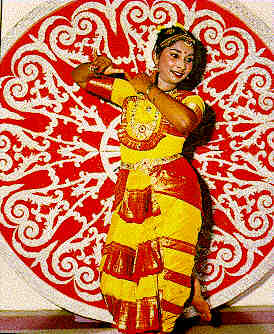 | Dancing and singing began as an expression of joy during festivals. In the dim and hazy past of Human social evolution festivals must have originated as occasions for rejoicing due to a successful hunt and later due to a successful harvest. These occasions must have stimulated inarticulate shouting and gesticulating from which could have originated singing and dancing. |
A Successful Hunt was the First Occasion of Rejoicing in Human History
In the harsh environment of earlier times when Man depended solely on hunting - a successful hunt called for celebration. This celebration must have normally been around the fireplace where the hunted animal was roasted. Such an occasion for rejoicing must have stimulated inarticulate shouting and gesticulating from which could have originated singing and dancing. Even a close observation of the tribal way of life, today would show how near this hypothesis is to reality.
Even in our civilized way of life, singing songs (devotional or otherwise) and dancing, alongwith specially prepared delicacies continue to be a part of any festival. Delicacies cannot be separated from a festival. No festival is complete without the feasting part. This might be a carryover from the days of hunting when a successful hunt, meant an occasion for rejoicing - which in later times took on the form of regular festivals. In an agricultural society, the occasion for feasting was logically at the end of a harvest. (As in today's industrial and commercial age, the finalization of accounts and bank closing are an occasion for rejoicing.) In fact in India the mention of any festival evokes memories of the particular delicacies associated with the festival. The same is true for any festival across the globe.
Festivals that centered around a successful hunt, had to take place, at irregular intervals because they depended on success at hunting. But with the coming of settled agriculture, the harvest became an occasion for rejoicing. More importantly these occasions for rejoicing obtained a seasonal regularity. With the repetition of the same festival at around the same time - year after year helped the festivities to take on a definite pattern. It was at this stage that the practices of observing festivals ceased to take place at a random frequency and began to take the form of a tradition.
Festivals arose out of some necessity of day-to-day life of the hazy past and were later transformed into customs, due to which they obtained a changeless character
What began as at habit was transformed into a custom. This way, different customs and traditions came to be associated with different festivals. And once, habits arising out of necessity of the environment were transformed into customs, they obtained a changeless character. It was this character that was responsible for perpetuating the existence of customs even after the environment that had given birth to them no longer existed. What had begun as a social necessity, changed into a custom, had now become a ritual. A ritual that was continued to be performed not because the way of life or the natural environment demand it, but because it had been performed so far and had been handed down from generation to generation, till human memory could recollect.
Another very significant factor that went into the making of festivals along with seasonal regularity, was religious sanction. As long as festivals were only social functions, they were optional in nature and need not have had general approval and mass participation. But mass participation is a very essential element that transforms rejoicing into a festival. A medium was necessary to obtain this mass participation. Religious sanction satisfied this need. In tribal and agrarian societies the fear of the supernatural and feeling of dependence on the of nature is very high.
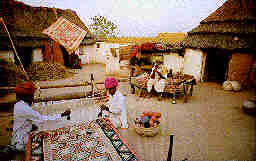 | In an agricultural society, the occasion for feasting was logically at the end of a harvest. With the coming of settled agriculture, the harvest became an occasion for rejoicing. More importantly these occasions for rejoicing obtained a seasonal regularity. With the repetition of the same festival at around the same time - year after year
helped the festivities to take on a definite pattern. It was at this stage that the practices of
observing festivals ceased to take place at a random frequency and began to take the form of a tradition. Festivals arose out of some necessity of day-to-day life of the hazy past and were later transformed into customs, due to which they obtained a changeless character. What began as at habit was transformed into a custom. This way, different customs and traditions came to be associated with different festivals. And once, habits arising out of necessity of the environment were transformed into customs, they obtained a changeless character. It was this character that was responsible for perpetuating the existence of customs even after the environment that had given birth to them no longer existed. What had begun as a social necessity, changed into a custom, had now become a ritual. A ritual that was continued to be performed not because the way of life or the natural environment demand it, but because it had been performed so far and had been handed down from generation to generation, till human memory could recollect. Another very significant factor that went into the making of festivals along with seasonal regularity, was religious sanction. As long as festivals were only social functions, they were optional in nature and need not have had general approval and mass participation. But mass participation is a very essential element that transforms rejoicing into a festival. A medium was necessary to obtain this mass participation. Religious sanction satisfied this need. |
Such an atmosphere is very ideal and congenial for traditions and taboos to thrive. For this reason people in tribal or agrarian societies are deeply religious. This elevates anything that has religious sanction to the level of a fanatical creed. When religion sanctified festivals became obligatory to observe them. But this was a positive development, because with festivals becoming a regular occasion of general rejoicing they became occasions that were looked forward to. Human beings were spurred on in their daily life with the idea of an approaching festival. Festivals became occasions around which activity revolved and they gave a purpose in life as well as a zest for living.
The fact that festivals originated as occasions for rejoicing is evident from the word we use for them i.e. Utsava which is close to the word for rejoicing i.e. Utsaha. The other word for festival i.e. Samarambha means 'that which begins everywhere at the same time', also testifies to the origin of festivals as a social and public event. 'Sama' means equal and 'arambha' means beginning.
The Social Origin of Festivals is Entangled into the Myth and Legend woven around them
The social origin of every festival that we observe would be evident if we examine closely the rituals associated with each of our festivals. The rituals, no doubt have to be disentangled from the mass of myth and legend into which they have been enmeshed. These complications, as we shall see, at times make it nearly impossible to decipher the ritual and get an idea as to the origin of the festival in the socio-economic life of antiquity.
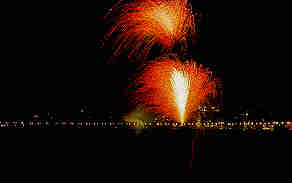 | Diwali or Deepaavali means an array of lamps (Deep = Lamp, Vali =Array). This is one of the major festivals in the Hindu calendar. It occurs in October/November, and is spread over four days. Dhanteras (Dhanatrayodashi) is the first day or rather the eve of the day on which the festival begins. Narkachaturdashi which is also known as Kalichoudas or Bali Pratipada is the second day. Laxmi Pujan and New year (Padava) normally occur (depending on the Hindu calendar) simultaneously on the third day and Bhaiya-duj is the last day. This is a very popular festival in many parts of India. The celebration of Diwali is marked by the lighting of innumerable lamps in every courtyard and the bursting of crackers. |
Diwali or Deepaavali means an Array of Lamps (Deep = Lamp, Vali =Array)
The first festival we take up is that of Diwali. Diwali or Deepaavali means an array of lamps (Deep = Lamp, Vali =Array). This is one of the major festivals in the Hindu calendar. It occurs in October/November, and is spread over four days. Dhanteras (Dhanatrayodashi) is the first day or rather the eve of the day on which the festival begins. Narkachaturdashi which is also known as Kalichoudas or Bali Pratipada is the second day. Laxmi Pujan and New year (Padava) normally occur (depending on the Hindu calendar) simultaneously on the third day and Bhaiya-duj is the last day.
This is a very popular festival in many parts of India. The celebration of Diwali is marked by the lighting of innumerable lamps in every courtyard and the bursting of crackers. Sweetmeats, new clothes etc., are there as in other festivals. The time for rejoicing is mainly early morning and late night. These hours of darkness bordering the waking hours are preferred as lights and crackers are the highlights of the festivities and these need darkness to have their illuminating effect. Hence people rise early and go late to sleep.
Deepavali - A Harvest Festival?
Worship of the Goddess of Wealth (Laxmi), observance of the New Year and performance of Aarti (a ritual that combines worship and adoration) are a part of the festival On the second day of Deepavaali (Kali Choudas) a ritual that is strongly suggestive of the origin of Deepavaali as an harvest festival is performed. On this day delicacies are prepared from pounded semi-cooked rice (called Poha or Pova). This rice is taken from the fresh harvest available at that time. This custom is prevalent both in rural and urban areas especially in Western India. In rural areas, Diwali signifies only this aspect. As it is Diwali which is celebrated sometime in October/November co-incides with the end of a harvesting season, known as the Kharif season when the fresh crop of rice is available.
Laxmi Pujan - A Veneration of the Prosperity at the end of an Harvest?
And as mentioned earlier in this chapter, the harvest was an important occasion for rejoicing in all agrarian societies. Diwali which occurs at the end of a cropping season has along with the above custom, a few others that re-inforce the hypothesis of its having originated as a harvest. Every harvest normally spelt prosperity. Veneration of this prosperity must have been at the origin of the worship of the Goddess of wealth (Laxmi).
For Farmers, a Festival marking the end of one Harvest and the beginning of another, was a festival heralding the beginning of a New Year
The association of the New Year (termed) Padava or Padavo, with Diwali also substantiates the harvest festival theory. The end of one harvest and beginning of another meant the end of one cycle of activity and the beginning of another, as all activities in an agrarian economy must have been linked-up largely with agriculture. Hence it was quite natural to look upon a festival that was observed at the end of one harvest season and the beginning of a new one, as a festival heralding the beginning of a new year. Gudi Padava which is also looked upon as a new year in some parts of India (Maharashtra, Karnataka, Andhra) also occurs at the end of another croppping season (the Rabi season) and co-incides with a harvest. This festival comes around March. And finally both the occasions on which the new year is observed are called Padava.
The word Padava is etymologically quite close to the Sanskrit word for crop which is Pradurbhu. Padava might be a corrupted form of the original word for "crop" which was used to term the new year festival. The inference that can be drawn from the above clues is that Diwali as a festival owes its origin to the reaping of a harvest.A Harvest presented a logical occasion for rejoicing and merriment.
The Mythology Associated with Deepavali
Mythology has its own reason to offer for the Diwali festival. According to mythology, the celebration of Diwali is closely bound up with one of India's two classic epics the Ramayana. (Mahabharata being the other epic). In brief the Ramayana story is as follows:
Dashratha, goes on a Hunt and Wounds a Human
Dasharatha the king of Ayodhya had once set off to hunt deer. In the midst of the forest he heard the sound of bubbles and saw some movement in the distance. Thinking it to be a deer drinking water, he shot an arrow in that direction. Much to his surprise, as his arrow found its mark, he heard a human being cry out. When he rushed to the spot his dis-believing eyes saw a handsome youth fatally wounded by his Sad as he was, Dashratha took the dying youth, whose name was Shravana to his (the youth's) blind parents, who were nearby. On hearing from Dashratha, the demise of their only son, they cursed him that he too would find himself in the same agonizing state when his son would be snatched away from him.
Dashratha Grants Three Boons to Kaikeyi
Long after this incident faded away, King Dashratha continued to reign over Ayodhya. One success followed another and with his three wives and four sons, he was a model of happiness. His first wife bore him Rama, the second one Sumitra bore him Laxman and the last one Kaikeyi bore him Bharat and Shatrughna. Each son was nobler than the other. Once during a battle, a wheel of Dashratha's chariot came off, Kaikeyi who had accompanied him to the battle inserted her hand into the axle and held the wheel in place. Her brave gesture enabled Dashratha to win the battle. In return Dashratha granted her three boons and told her to ask for anything she wanted. As she wanted nothing at that moment she reserved the right of asking for their fulfilment for some later date.
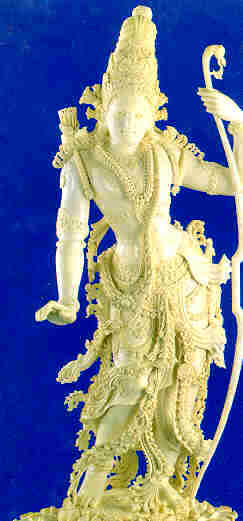 | An Ivory image of Lord Rama. According to mythology, the celebration of Diwali is closely bound up with one of India's two classic epics the Ramayana. Lord Rama is said to have reigned for a long time during which the people were happy and contented. Ramrajya (the reign of Rama) has come to connote an era of peace and prosperity. The festival of Diwali; we were told is celebrated to commemorate Rama's return from exile. Ramnavami;, another festival is celebrated as the birthday of Lord Rama, sometime in March. |
Rama Goes in to Exile
This second episode also became a thing of the past. After a few more years when Dashratha's eldest son Rama attained manhood, Dashratha felt it was time up for him to renounce worldly pleasures and relinquish his throne in favour of Rama. On hearing this, the people of Ayodhya were jubilant. But all human minds are not identical. Kaikeyi's maid Manthara was jealous of Rama and to prevent his accession to the throne, she went to Kaikeyi and instigated her against Rama by telling her that if Rama became king, she (Kaikeyi)would lose her importance as queen. So she should ask Bharat (Kaikeyi's son) to be installed aiking and Rama be exiled for fourteen years. And if Dashratha did not accept these demands, Kaikeyi should ask him to redeem the boons that he had granted her. In the beginning Kaikeyi resisted Manthara's malicious advice, but as temptation got the better of sagacity, she relented and Dashratha had to redeem the three boons by:
1. Not making Rama the King of Ayodhya
2. Agreeing to install Bharat on the throne of Ayodhya,
3) Asking Rama to into exile for 14 years.
Sadly Dashratha agreed and Rama set off for exile with his wife the virtuous Sita and his noble brother Laxman. Soon afterwards, Dashratha died, a heartbroken man. Not only had Dashratha's boons been redeemed but also the curse of Shravana's broken hearted parents, the occurrence of which had escaped Dashratha's memory.
Rama Battles Ravana
The story of Ramayana does not end here. In exile Sita is abducted by Ravana (King of Rakshashas - Demons) and taken to his abode Lanka (modern day Sri Lanka or Ceylon). Rama and Laxman, collect an army with the help of the monkey king Hanuman (possibly a tribal chief) and rescue Sita.
At the end of fourteen years, Rama, Laxman and Sita return to Ayodhya and are given a hero's welcome by the people. Lord Rama is said to have reigned for a long time during which the people were happy and contented. Ramrajya (the reign of Rama) has come to connote an era of peace and prosperity. The festival of Diwali; we were told is celebrated to commemorate Rama's return from exile. Ramnavami;, another festival is celebrated as the birthday of Lord Rama, sometime in March.
The Legend of King Bali
Another legend is associated with Diwa1i and that is of King Bali. This king, we are told, also had a long and happy reign. To propitiate the gods he performed a Yagna (fire sacrifice). So successful was his Yagna that even the gods were terrified to appear before him and grant him a boon in the fear that what he might ask could be beyond their capacity to satisfy. To avoid embarassment the gods sent one of them to King Bali's court in the guise of a sage. When the Sage reached King bali's court, Bali asked him to ask for anything he wanted. Facing the righteous King, the sage asked for space for three paces. This request seemed strange to all the courtiers, but king Bali granted it. Once the request was granted to him, the wily Sage, who was none but god in disguise, submerged the entire world (Mrityu-loka) with one step, with the second he submerged heaven (Swarga-loka) and for the third step; there was no respectable place to put his foot down and so he asked the bewildered Bali for some respectable place to this foot so that the boon could be fulfilled. Left with no alternative, the noble but exasperated King Bali offered his head for the purpose. To his surprise, the wily sage not only lost no time in placing his foot over King Bali's head, but also thrust Bali into the nether worlds (Patala-loka) which as per Hindu cosmogony is hell and lies below the surface of the earth.
In memory of this, we are told, that the second day of Diwali (Bali Prati-pada) is celebrated. Prati-pada here translates as "below the opponent's foot" (Prati=opponent, Pada=foot).
The Legend of Demon Narakasura
The Third mythology associated with the celebration of Deepavali is that of the slaying of the Demon Narakasura by Lord Sri Krishna. In Western and Southern India on Naraka-chaturdashi day during Deepavali, to re-enact the slaying of the demon Narakasura by Lord Sri Krishna, Hindus smash a bitter fruit (called Kaarita) with their big toe. This is done after having a ceremonial bath in which sandalwood paste and sweet smelling essences are used.
But this mythology and ritual is associated with Deepavali only in the Western and Southern India, it is not known in the north and east. Bharatvarsha with its multifarious and colourful legends has many festivals with which different mythologies have become associated. These mythologies differ from region to region and have contributed in making the composite and colourful society of the Hindus.
Navaratri and Dassera
Navaratri and Dassera are also long festivals celebrated over a period of ten days. The first nine days constitute the Navaratri festival. Navaratri itself means nine nights (Nava = nine, ratri = night).The term "Dassera" or "Vijayadashmi" which is the last and tenth day are derived from the word for number ten i.e. Das (in Hindi) or Dasha (in Sanskrit). .
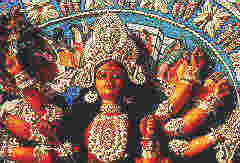 | In eastern India (especially in Bengal) the Durga Pooja festival which is part of Navaratri, is the principal festival and is celebrated with gaiety and devotion through public ceremonies (Sarvajanik of Sarbojanin Durga Puja). For these ceremonies Pundals (temporary public booths) are erected. The ceremonies are conducted amidst grand prayers and mass feeding. |
Navaratri is Dedicated to the Mother-Goddess
This festival is devoted to the Mother Goddess known variously as Durga, Kali, Bhavani, Amba, Chandika, etc. This festival is celebrated in different ways in different parts of India. The western India (Gujarat and Rajasthan) throughout the nine days, both men and women participate in a dance in which they go in circles around an object of worship. This dance style is a very popular one during this festival. The dances start after 10 p.m. and many a times they continue up to the small hours of the morning. In eastern India (especially in Bengal) this festival is the principal festival and is celebrated with gaiety and devotion through public ceremonies (Sarvajanik of Sarbojanin Durga Puja). For these ceremonies Pundals (temporary public booths) are erected. The ceremonies are conducted amidst grand prayers and mass feeding.
Navaratri in South India
In southern India celebrations constitute a display of images of God and toys at home for nine days. In northern India, on the tenth day (Dassera) giant effigies of Ravana. Kumbhakarna and Meghnad (Lord Rama's enemies), are publicly burnt. But despite the various ways in which this festival is celebrated the feature that is common is that of the worship of the mother goddess. This is evident in the above rituals.
The Garbha (Womb) Dance
The Garbha Dance dance in western India is performed around a pot containing a lamp. The word "Garbha" by which the pot as well as the dance is known is etymologically close to the word Garbha meaning womb. In this context the lamp in the pot, symbolically represent life within a womb. Another prevalent practice is of sowing pulses, cereals and other seeds on the first day of this festival in a pot, which is watered for nine days at the end of which the seeds sprout. This pot is worshipped throughout the nine days. This custom is also indicative of fertility worship.
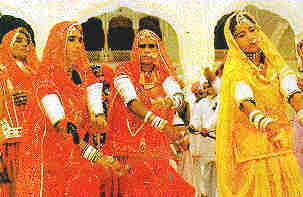 | The Garbha Dance dance in western India is performed around a pot containing a lamp. The word "Garbha" by which the pot as well as the dance is known is etymologically close to the word Garbha meaning womb. In this context the lamp in the pot, symbolically represent life within a womb. Another prevalent practice is of sowing pulses, cereals and other seeds on the first day of this festival in a pot, which is watered for nine days at the end of which the seeds sprout. This pot is worshipped throughout the nine days. This custom is also indicative of fertility worship. |
No Male God is worshipped during Navaratri
Significantly, no male God is associated with Navaratri. Thus contrasts strongly with other festivals in which male gods are dominant e.g. Ganesh Chathurti, Krishnastami (Janmastami), Mahashivaratri, Ramnavami etc. Even when goddesses are worshipped in any of the other festivals, they are given this honour as consorts of the male god to whom the said festival is devoted. For instance, Sita with Rama during Ramnavami or Parvati with Shiva during Mahashivaratri. But during Navaratri the Mother goddess is not worshipped because she is a consort of some male god. In fact she has no consort (husband). She stands independent, and is worshipped in her own right. This reinforces the interpretation of rites performed during Navaratri as those originating in a festival eulogizing fertility in women.
 | The Ramlila ceremony observed in northern India on Dassera day, commemorates the victory of Rama over the demon-king Ravana and the rescue of Rama's consort Sita, whose chastity Ravana wanted to violate. Rama succeded in rescuing Sita unmolested from Ravana's cluthes. The reason for commemorating Rama's victory during Dassara might be that this victory had succeeded in preventing a woman's chastity from being violated. All these clues build up a case in favour of the Navaratri and Dassera festivals being based on the worship of the quality of fertility in women personified as a Mother Goddess. |
The Ramlila ceremony
The Ramlila ceremony observed in northern India on Dassera day, commemorates the victory of Rama over the demon-king Ravana and the rescue of Rama's consort Sita, whose chastity Ravana wanted to violate. Rama succeded in rescuing Sita unmolested from Ravana's cluthes. The reason for commemorating Rama's victory during Dassara might be that this victory had succeeded in preventing a woman's chastity from being violated. All these clues build up a case in favour of the Navaratri and Dassera festivals being based on the worship of the quality of fertility in women personified as a Mother Goddess.
Holi
Holi or Holikotsava is a festival that occurs around March and is celebrated over two days. On the evening of the first day bonfires are lit, normally in a public place. On the second day people throw coloured powder and water at each other. The first day is Holi proper, the second day is called Dhuleti or Rangapanchami (Ranga-colour, Panchami=fifth day). Rangapanchami was originally the fifth day as the festival was earlier spread over five days and so it was called Rangapanchami because in earlier times it was celebrated till the fifth day of the fortnight.
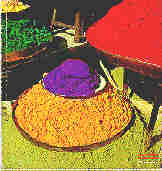 | Holi or Holikotsava is a festival that occurs around March and is celebrated over two days. On the evening of the first day bonfires are lit, normally in a public place. On the second day people throw coloured powder and water at each other. The first day is Holi proper, the second day is called Dhuleti or Rangapanchami (Ranga-colour, Panchami=fifth day). Rangapanchami was originally the fifth day as the festival was earlier spread over five days and so it was called Rangapanchami because in earlier times it was celebrated till the fifth day of the fortnight.. |
Holi Centers Around a Bonfire
Holi is one of the few festivals that has yet to acquire the character of being a religious and private festival along with being a public occasion for rejoicing which all festivals are. Holi is almost totally a public festival and as such there is hardly any Holi celebrations inside private homes in the sense in which is understood. Holi is not only a purely public festival in the manner of its celebration but also in the manner in which people prepare for it.
Weeks before the arrival of Holi, gangs comb the neighbourhood and collect all waste-wood, old wooden furniture etc. which they can lay their hands upon. After weeks of preparation judiciously combined with activities that come close to pillaging, assorted pieces of wood are piled up to be lit on the evening of the festival day. (These days with Cable TV, the interest of the boys in urban India seems to be waning in the pre-holi preparations)
Sexual License during Holi
The lighting takes place late in the night between 10 P.M. and 12 P.M. Very rarely is this ceremony conducted in an orderly manner. Except when the ceremony is taking place in a temple, gesticulation, howling, catcalls and trading of abuses is a part of Holi. All this is obviously reminiscent of attitudes originating in a backward cultural environment. But even against this background, the aspect that stands out is the sexual license that the mobs exercise. A display of loose morals, a morbid rejoicing with contempt for all laws and norms of behaviour that are considered civilized by present-day standards - what does this reflect?
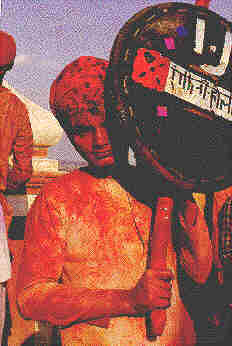 | Festivals displaying features similar to Holi can be found in many modern societies. Carnival and Guy Fawkes Day are two instances. The Guy Fawkes Day which is observed in Britain on the 5th of November commemorates the discovery of Gunpowder and is celebrated with fireworks and bonfires. The Carnival which is another instance of a similar festival is celebrated in Portugal and Spain. Carnival is an occasion for revelry. Carnival that is celebrated before the beginning of Lent - the beginning of the austerity period that goes up to Good Friday and Easter. The term carnival being close to terms like carnal (meaning sensual or bodily), carnage, carnivore, carnivorous is itself quite suggestive of the origin of carnival in a less civilized environment. Recently in India the Roman Catholic Church of Goa has refused to extend religious sanction to carnival, but this has not succeeded in abating the tide of public enthusiasm. This is one instance of how a popular festival which owes it origin to a lifestyle (existing or extinct) can continue in face of withdrawal of religious sanction.. |
How is it that even those sections of society that are educated and cultured allow themselves to bo carried away by the wild outburst associated with this festival? Why is it that this has been the nature of Holi for centuries together?
These questions sound quite provocative to an average Indian mind. To answer them we need to look beyond what is visible and evident as there is more to it than meets the eye during Holi celebrations. As already mentioned, Holi does not have much of a private or individual character, it is almost entirely a public festival. But does it at least have any religious significance? A hard look proves otherwise. Holi is not dedicated to any deity from the Hindu pantheon, as are other festivals like, Mahashivaratri, Ramanavami, Krishnastami, etc. And although mythology does involve Shiva and Madana ( the God of love) with Holi, the religious significance is not immanent as in the case of other festivals. It is for this reason that very few religious rites are associated with Holi and almost none of them are generally observed.
Holi Originated in the Tribal Past?
The on-goings during Holi celebrations closely resemble life in a nomadic tribal society especially in the wintry regions. The festival revolves around a bonfire. It is observed in the winter. These two aspects are eloquent as to the festival's social origin. Fire, we know was one of the earliest tool used to ward off the freezing cold of the long winters in the northern hemisphere. Even today among the poorest sections of society, the lighting of fire made of waste-wood is the cheapest and affordable form of keeping oneself warm during the long wintry nights.
Although no offence is meant, we cannot help saying that the tradition of mobocracy and sexual license reflects in a telling manner an attitude typical of tribal people living in a harsh environment in a society where the institution of monogamous marriage had not developed fully.
Carnival and Guy Fawkes Day - Festivals Similar to Holi are Found in other Cultures
But such elements in a festival are not specific to India. Festivals displaying features similar to Holi can be found in many modern societies. Carnival and Guy Fawkes Day are two instances. The Guy Fawkes Day which is observed in Britain on the 5th of November commemorates the discovery of Gunpowder and is celebrated with fireworks and bonfires.
The Carnival which is another instance of a similar festival is celebrated in Portugal and Spain. Carnival is an occasion for revelry. Carnival that is celebrated before the beginning of Lent - the beginning of the austerity period that goes up to Good Friday and Easter. The term carnival being close to terms like carnal (meaning sensual or bodily), carnage, carnivore, carnivorous is itself quite suggestive of the origin of carnival in a less civilized environment. Recently in India the Roman Catholic Church of Goa has refused to extend religious sanction to carnival, but this has not succeeded in abating the tide of public enthusiasm. This is one instance of how a popular festival which owes it origin to a lifestyle (existing or extinct) can continue in face of withdrawal of religious sanction.
The Burning of Kama Deva Madana
For that matter, a formal religious sanction does exist in the case of most festivals. For instance, it is said that Holi commemorates an event in lord Shiva's life. In mythology Shiva is portrayed as having a meditative but violent temperament. For hours together he is said to meditate in his icy abode atop mount Kailas in the Himalayas. Solitude and serenity are essential for him. Looking at Shiva's abnormal trait, Madana, the God of love decided to see for himself if Shiva was, in fact, above normal passions. To do this he took on the form of a beautiful nymph and tried to disturb Shiva's meditation by singing and dancing in front of him. Unfortunately for Madana, he succeeded in disturbing Shiva's meditation, and when Shiva opened his eyes and recognised the beautiful nymph as Madana in disguise, he was furious. In a fit of rage he opened his third eye located on his forehead, that could emit fire and reduced the guileful Madana to ashes. Holi we are told is observed in memory of this event.
.
_____________________________________________________________
_________________________________________________________________________________
____________________________________
|
|
_ _ _ |
View My Guestbook
|
